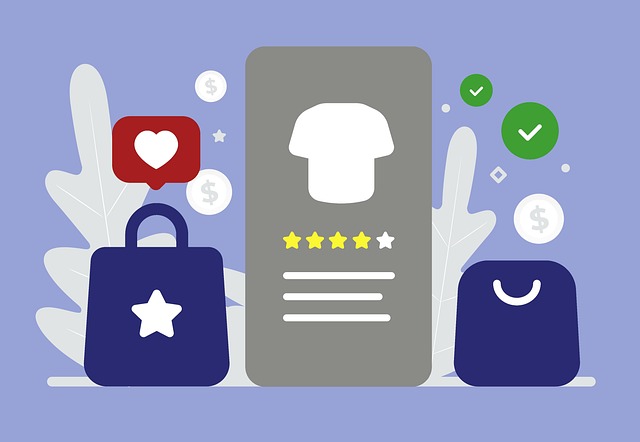AI-powered ecommerce is transforming retail by offering personalized experiences, automating services, and improving operational efficiency. Defining chatbot scope, designing effective conversational flows, and selecting suitable technology platforms are crucial steps for successful implementation. Once launched, continuous optimization through user feedback and performance analytics ensures the AI chatbot remains competitive, enhancing the shopping journey in dynamic e-commerce environments.
Looking to revolutionize your eCommerce with AI? Building a chatbot can significantly enhance customer engagement and sales. This comprehensive guide walks you through every step, from understanding the potential of AI-powered eCommerce to designing conversational flows, choosing the right technology, and continuous optimization. By the end, you’ll be equipped to implement a powerful chatbot that drives results.
- Understanding AI-Powered Ecommerce and its Potential
- Defining the Purpose and Scope of Your Chatbot
- Designing Conversational Flows for Effective Interactions
- Choosing the Right Technology and Development Platforms
- Implementing, Testing, and Optimizing for Continuous Improvement
Understanding AI-Powered Ecommerce and its Potential

In today’s digital era, AI-powered ecommerce is transforming the way businesses interact with their customers. By leveraging artificial intelligence, retailers can offer personalized shopping experiences, automate customer service tasks, and enhance overall efficiency. Chatbots, driven by AI, play a pivotal role in this evolution. They can engage with customers, answer queries, provide product recommendations, and even facilitate purchases, all while learning from each interaction to continually improve their performance.
The potential of AI-powered ecommerce is vast. It enables businesses to scale operations without compromising on personalized service, allowing them to cater to a larger customer base. Moreover, AI can analyze vast amounts of data to uncover valuable insights about consumer behavior and preferences, empowering retailers to tailor marketing strategies for maximum impact. This not only boosts sales but also fosters stronger customer relationships, setting the stage for sustainable growth in an increasingly competitive market.
Defining the Purpose and Scope of Your Chatbot

Defining the purpose and scope of your chatbot is a crucial step in the development process for any AI-powered ecommerce platform. Before you begin building, consider what specific tasks or inquiries your chatbot will handle. Will it assist customers in finding products, provide information about shipping and returns, or offer personalized recommendations based on browsing history? Clearly understanding your chatbot’s role ensures that its capabilities align with customer needs and expectations.
The scope of your chatbot also determines its interaction limits. For instance, a narrow-scope chatbot might handle only product queries, while a broader one could facilitate the entire purchasing journey, from initial product interest to post-purchase support. This definition will guide your design choices, including the types of AI technologies employed, such as natural language processing (NLP) for understanding user intent or machine learning algorithms for adaptive learning and improvement over time.
Designing Conversational Flows for Effective Interactions

Designing effective conversational flows is a key aspect of building successful AI-powered ecommerce chatbots. The goal is to create natural, intuitive interactions that guide users through their purchasing journey seamlessly. Start by mapping out potential user queries and desired outcomes for each touchpoint. Will they be looking for product recommendations, tracking orders, or receiving support? Crafting well-defined paths ensures the chatbot can provide accurate, relevant responses at every step.
Consider incorporating branching conversations to accommodate diverse user needs. For instance, after a customer inquires about a specific product, the chatbot might offer related items or accessories as suggestions. By tailoring these conversations, you enhance the user experience and increase the chances of conversions. Remember, a well-designed flow keeps users engaged, making AI-driven ecommerce interactions both productive and enjoyable.
Choosing the Right Technology and Development Platforms

When building an AI-powered chatbot for ecommerce, selecting the right technology and development platforms is a pivotal first step. Look for robust, scalable solutions that integrate seamlessly with your existing ai powered ecommerce infrastructure. Popular options include platforms that offer pre-built conversational flows, natural language processing (NLP) capabilities, and easy integration with popular shopping carts and customer relationship management (CRM) systems. These tools streamline development, ensuring your chatbot can understand and respond to customer queries effectively.
Consider factors like customization options, cost, ease of use, and community support when choosing a platform. Advanced platforms allow for fine-tuning responses and integrating personalized recommendations, enhancing the user experience. Additionally, opt for solutions that provide analytics and insights into chatbot performance, enabling you to continually optimize interactions and drive sales in your ai powered ecommerce environment.
Implementing, Testing, and Optimizing for Continuous Improvement

After developing your AI-powered chatbot, implementing it on your e-commerce platform is the next crucial step. This involves seamlessly integrating the chatbot into your existing infrastructure to ensure a smooth user experience. Once integrated, thorough testing becomes essential to identify and rectify any issues or bugs that may arise from the combination of human interaction and automated processes. Utilize diverse test scenarios, including common queries, edge cases, and potential system failures, to validate the chatbot’s functionality and accuracy.
Continuous optimization is vital for maintaining a high-performing AI-powered ecommerce chatbot. Regularly analyze user interactions, gather feedback, and monitor key performance indicators (KPIs) such as response accuracy, customer satisfaction ratings, and conversion rates. Leveraging this data allows you to refine the chatbot’s algorithms, improve its conversational abilities, and tailor responses to better meet customer needs. This iterative process ensures your chatbot remains competitive and delivers an enhanced shopping experience in the dynamic world of AI-powered e-commerce.
Building a chatbot for e-commerce is a strategic move to enhance customer engagement and drive sales in the competitive digital landscape. By leveraging AI-powered solutions, businesses can create intelligent virtual assistants that provide personalized shopping experiences, 24/7 support, and efficient problem-solving. Through well-defined conversational flows, these chatbots become powerful tools for converting browsers into buyers, ultimately boosting revenue and customer satisfaction. Remember, continuous optimization is key to ensuring your chatbot remains a game-changer in the ever-evolving world of ai-powered ecommerce.
